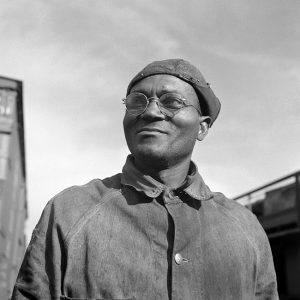calsfoundation@cals.org
Robert Lee Hill (1892?–1963)
Robert Lee Hill was an African-American leader who was forced to flee Arkansas during the bloody Elaine Massacre of 1919. He spent the rest of his life in Topeka, Kansas, repairing freight cars for the Santa Fe Railway.
Robert Hill was born in Dermott (Chicot County), the son of Robert L. Hill Jr. and Elizabeth Griffin Hill. He was born on June 8, but the exact year of his birth is inconsistently reported in official records, ranging from 1892 on his World War I draft registration card to 1898 on his Kansas death certificate.
Hill married Hattie Alexander in 1916. In 1917, Hill was working at the Valley Planting Company in Winchester (Drew County).
Hill was a grand counsellor, with the authority to pay for legal advice, in the Progressive Farmers and Household Union, an organization that angered white plantation owners when it suggested that black sharecroppers in the Arkansas Delta hire legal representation to get fair prices for their cotton. The result was a riot, started on September 30, 1919, near Elaine, where a union meeting was under way. On the morning of October 1, not knowing about a shooting the night before at Hoop Spur (Phillips County), Hill and Ocier S. Bratton, son of Little Rock (Pulaski County) attorney Ulysses S. Bratton, took a train to Ratio (Phillips County), near Elaine, to collect stories and contracts from sharecroppers. Hill knew people in Ratio because his mother, who was part Cherokee, lived there.
Amid the rioting, Ocier Bratton was taken in chains to Helena (Phillips County) and jailed for a month. Hill was hidden by friends, and with help from a white family, he left Arkansas, traveling to Boley, Oklahoma, which was an all-black community, and to South Dakota before reaching Kansas.
He wrote to a member of a black Masonic lodge, a Mr. Henderson, asking him to bring his family to meet him. Before leaving Arkansas, Henderson notified the sheriff of an adjoining county about Hill’s request. When Henderson and Hattie Hill arrived in Kansas City, Missouri, on January 20, 1920, the Topeka chief of police arrested Robert Hill and Hattie Hill, taking them to a jail in Topeka. She was released, but Hill stayed in jail for months.
After a vigorous defense led by the National Association for the Advancement of Colored People (NAACP), Kansas governor Henry J. Allen refused in March 1920 to allow Hill’s extradition to Arkansas for trial. Federal charges were dismissed in October. Hill offered his services to the national NAACP, but it suggested he join the Topeka branch.
Articles about the Elaine Massacre report that Hill was “lost to history.” Yet he was in plain sight, listed in the Topeka city directory. He worked for the Santa Fe Railway as a carman and rivet driver from 1922 to 1962, the first two years under the assumed name of George L. Smith. Jack Delano, a photographer for the U.S. Farm Security Administration’s Office of War Information, took a picture of Hill at work there in March 1943. Hill and his wife adopted and raised their grandson, Robert Lee Hill V.
Hill died on May 11, 1963, in Topeka and is buried in the Topeka Cemetery.
For additional information:
Cortner, Richard C. A Mob Intent on Death: The NAACP and the Arkansas Riot Cases. Middleton, CT: Wesleyan University Press, 1988.
Gruber, John. “Robert Lee Hill.” Railroad History 211 (Fall–Winter 2014): 58–59.
Stockley, Grif, Brian K. Mitchell, and Guy Lancaster. Blood in Their Eyes: The Elaine Massacre of 1919. Rev. ed. Fayetteville: University of Arkansas Press, 2020.
John Gruber
Madison, Wisconsin
 Civil Rights and Social Change
Civil Rights and Social Change Early Twentieth Century, 1901 through 1940
Early Twentieth Century, 1901 through 1940 Labor Movement
Labor Movement Robert L. Hill
Robert L. Hill 




Comments
No comments on this entry yet.